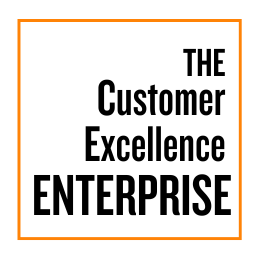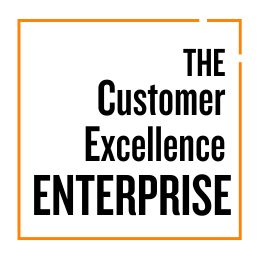
The Customer Excellence Enterprise: A Playbook for Creating Customers for Life,
[PART 2] Are CMOs and Marketers Disposable or Indispensable?
[Part 2]: The Future of Marketing is Customer-Centric: Are CMOs and Marketers Disposable or Indispensable?
REFERENCE: “The Customer Excellence Enterprise: A Playbook for Creating Customers for Life”
Chapter 10: Reimagining Commercial DNA
Are CMOs and Marketers Disposable or Indispensable?
In The Future of Marketing is Customer-Centric (PART 2), we build on the foundation of the impact of AI and Experiential Commerce established in PART 1 to focus on a fundamental question: Are CMOs, Marketers and Marketing Disposable?
Synopsis. Over the last fifteen years, marketing has enjoyed a period of influence and investment not seen since the Mad Men era, when television advertising and mass media transformed brands into cultural icons. Venture capital and corporate spending have fueled a marketing arms race as CMOs have wielded unprecedented budgets to experiment with content, influencers, automation, and AI. Yet, as with every cycle of investment and exuberance, the question now looms: how long can the glory days last? As AI automates more aspects of marketing execution and CFOs begin scrutinizing ROI with increasing intensity, CMOs and marketers are facing real cyclical and structural threats —The Four Horsemen of Modern Marketing—and another pivotal question: Are CMOs and marketers disposable?
With a unique capacity to capture the imagination, generate demand, and even shape culture, it’s not hard to think of marketers as the corporate version of the "rich cousins". You know the ones, the cousins from the branch of the family with the beach house and summer vacations in Paris, the worldly ones that ate sushi and knew how to use chopsticks in elementary school. As the rich cousins of the corporate world, marketers get to dazzle the senses with Super Bowl commercials starring A-list celebrities, collaborate with TikTok and Instagram influencers, and get wined and dined by agencies courting their account.
Marketing's Paradoxical Cycle
Unfortunately, through the attention those high-profile campaigns, celebrity endorsements, and big-budget activations garner in the C-suite and across other functional areas and departments, marketing can often be mischaracterized as wasteful, extravagant, discretionary, and at worst, disposable. In companies where anything close to this perception takes hold, CMOs and marketers can find themselves in a bit of a paradoxical cycle:
- First, when times are good, companies invest freely in marketing to drive brand awareness, customer engagement, and revenue expansion.
- However, when the economic winds inevitably begin to change, and corporate belt-tightening kicks in, those hopeful investments quickly get reframed as sinister costs as marketing gets recast as a cost center rather than a growth engine.
- Next, marketers of all levels and stripes, who were seemingly just at the top of their game as “bells of the ball” at CES, Davos, and Cannes, are then among the first to get impacted with unfortunate reorgs and devastating “personnel actions”.
- Yet, as soon as the organization inevitably shifts back into growth mode, there seems to be a change of direction and a collective realization that strong marketing is essential to capture new opportunities, rebuild lost momentum, and differentiate in crowded and noisy markets.
- This leads to a rehiring and new investment wave, often with a new vision, fresh talent, and ambitious mandates—until the next downturn restarts the cycle.
This exposes a fundamental tension in many companies: marketing is expected to be a primary driver of growth and financial performance, yet when financial performance suffers, marketing (along with recruiting and sales) is often among the first functions to face increased scrutiny, severe budget cuts, and the extreme of layoffs. It’s like companies choose to slight their hand in the middle of a high-stakes poker game—the move feels instinctive and is done with a sense of certainty that it will work but ultimately ends up undermining any chance of changing their fortunes. This paradox surfaces deep questions about marketing, and whether it is truly viewed, valued, and treated as a business-critical function, something more discretionary, or in the worst case, disposable.
The Four Horsemen of Modern Marketing
The forces and factors underpinning marketing’s perception paradox can limit the ability for CMOs and marketers to assert the function’s true value, making it seem “disposable”. This fragility is not accidental—it stems from deep-seated structural and perception-driven barriers that weaken marketing’s strategic influence and make it an easy target in times of financial strain. These threats, The Four Horsemen of Modern Marketing, can hinder the function’s ability to drive sustainable growth through good times and bad:
1. THE COST CENTER CONUNDRUM—Marketing is often viewed as a cost center because its impact on revenue is not always immediate or directly measurable in the same way as sales. Investments in brand-building, customer engagement, and demand generation yield results over time, making them more difficult to quantify in traditional financial terms. This perception is further reinforced by misaligned measurement models that focus on short-term metrics like campaign performance and ad spend efficiency rather than long-term indicators such as share of wallet, repeat sales, customer lifetime value and brand equity. As a result, marketing can be undervalued as a financial contributor, often seen as more of an enabler rather than a revenue driver, leaving it vulnerable to budget reductions and leadership skepticism when the stakes are highest.
2. THE PRODUCT-BRAND TRAP—Customers no longer make purchase decisions solely on product factors nor do they blindly buy into brand messaging and advertising. With a habitual focus on product and brand attributes in marketing, what can get missed is the shift toward Experiential Commerce —where the company to customer value exchange has shifted from tangible to intangible, and experiential factors have become an equal partner to product and brand factors when customers are evaluating, choosing, and making purchasing and loyalty decisions. CMOs and marketers that double-down on the product-brand paradigm and fail to adequately consider experiential factors become increasingly misaligned with customer preferences and risk losing their competitive edge and ability to maintain relevance in their hearts, minds, and lives.
3. THE CAMPAIGN-CENTRIC FIXATION—Marketing campaigns can be alluring —working on film sets, collaborating with top agencies, and engaging with creatives is exciting stuff. Rather than fostering meaningful connections, campaigns risk becoming background noise—blending into the digital clutter as consumers tune out repetitive, impersonal messaging. This dynamic may be even more pronounced with the weaponization of digital marketing, which manifests in an unrelenting cadence of promotional messaging deployed across multiple channels at scale, creating a constant barrage of ads, emails, and social media posts. In this context, success is too often defined by campaign performance metrics like clicks, impressions, and engagement rates rather than long-term brand building and customer value. As a result, CMOs and marketers can get caught in a cycle of continuous customer acquisition campaigns without the necessary foundation for sustainability through retention and expansion, creating a revolving door of customers.
4. THE AI REPLACEMENT NARRATIVE—Fueled by AI and the democratization of digital marketing tools like Google Ads, Facebook, Adobe, and HubSpot, CMOs and marketers face a dilemma. While these technologies promise enhanced efficiency, automation, and data-driven decision-making, they also fuel a perception that marketing leaders and teams are becoming less essential. As AI optimizes media buying, personalizes content at scale, and generates predictive analytics with unprecedented speed, executives outside of marketing may begin to question the need for large marketing teams and sustained, outsized expenditures. Reinforcing this AI Replacement Narrative, which suggests that marketing expertise is increasingly replaceable by technology, there is a palpable expectation that efficiencies should follow the tech— people, lower costs, and faster results. Suppose marketing is seen merely as a set of automated workflows rather than a core driver of customer relationships, brand equity, and competitive differentiation. In that case, companies may strip it down to a leaner, tech-enabled function—eroding both influence and investment in the long term.
To counteract both the cyclical threats of capital reallocation and new priorities and the structural pressures of the "Four Horsemen", CMOs and marketers must fundamentally reshape their value proposition. The risk is that they may find themselves increasingly marginalized if they fail to redefine their value. In extreme cases, companies may even eliminate the CMO role or conclude that marketing can be absorbed into lines of business or some other enabling function. This means CMOs and marketers must pivot from a legacy campaign-centric mantra, making themselves indispensable by evolving to a new mindset and model that leverages technology as an enabler—rather than a replacement—of a deeply human approach where customers and marketers all win.
The Future of Marketing is Customer-Centric.
Five Essential Shifts: How CMOs and Marketers Become Indispensable
Hidden in the story of the Four Horsemen of Modern Marketing is good news around a singular purpose—Making CMOs and Marketers Indispensable. Specifically, to fight back against misperceptions of disposability, the future of marketing must be customer-centric. An untapped win-win opportunity for CMOs and marketers, with a customer-centric marketing model, both customers and marketers win. This approach requires structural and systemic changes and the need for CMOs, marketers and CX professionals to collectively adopt a new playbook focused on facilitating their companies and career paths through five essential shifts:
- The customer-led shift from tangible to intangible value exchange;
- The shift from a campaign-centric to customer-centric paradigm;
- Positioning experiential factors as an equal partner to product and brand factors in corporate value propositions;
- Evolving from a transactional to relationship-based mindset; and
- Delivering customer value beyond the funnel, across the entire customer lifecycle.
Fortunately, marketers can follow the lead of Customer Excellence Enterprises, perennially high-performing outliers that are predisposed to deliver exceptional experiences. This opportunity means evolving past the marcom stack to build integrated experience delivery systems like those at Amazon or The Ritz-Carlton. With this evolution to Customer-Centric Marketing, CMOs and marketers can reclaim their strategic influence and become indispensable by focusing on what truly matters: customers.
Key Takeaways
1. To combat budget cuts and layoffs during downturns, marketing leaders must continuously demonstrate their impact on revenue, customer lifetime value, and business growth.
2. Customers increasingly value seamless, personalized, and emotionally resonant experiences, meaning marketers must integrate experiential factors into value propositions rather than relying solely on product and brand attributes.
3. To escape the short-term, campaign-driven cycle, marketing must shift from transactional engagement to a relationship model, ensuring sustained value creation beyond the funnel and across the entire customer lifecycle.
Readiness Questions for CMOs and Marketers to Consider
1. Is marketing in our company viewed as a revenue-generating function, or does it still suffer from the perception of being a discretionary cost?
2. Are we prioritizing experiential value exchange, or are we still trapped in the product-brand paradigm and campaign-driven marketing model?
3. How well is our marketing function integrating AI and automation in a way that enhances customer-centricity rather than diminishing marketing’s perceived expertise and influence?
📙 Pick up your copy of my recently launched book, The Customer Excellence Enterprise (Wiley, 2024) Available at Amazon: https://lnkd.in/ehYMaNkW and all major booksellers
SUBSCRIBE to "The Customer-Centric Marketer"
LinkedIn
Newsletter here:
https://lnkd.in/ejXZttvn











